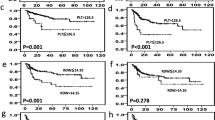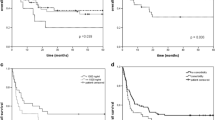Abstract
We evaluated RDW in a single-center series of 61 consecutive patients with primary and secondary MF at diagnosis and during treatment with ruxolitinib (RUX) and examined any possible prognostic impact. Elevated RDW values were present in all but 4 patients at diagnosis with a median RDW of 18.9%. RDW was higher in subjects with palpable splenomegaly (p = 0.02), higher ferritin, as well as among those cases who did not receive any cytoreduction before RUX (p = 0.04). Interestingly, higher RDW at diagnosis also correlated with a shorter time from MF diagnosis to RUX start (-4.1 months per one RDW unit; p = 0.03). We observed a modest increase (< 1%) in RDW during the first 6 months of RUX treatment. In a multivariable random-intercept model that considered all time points and contained the covariates time and RUX dose, we also observed a clear decrease in RDW with increasing hemoglobin (Hb) during RUX (slope: -0.4% per g/dL of Hb; p < 0.001). The median RDW at diagnosis of 18.9% was used as a cut-off to identify two subgroups of patients [Group 1: RDW 19.0-25.7%; Group 2: RDW 13.1-18.7%], showing a difference in mortality [Group 1 vs. 2: crude HR 2.88; p = 0.01]. Using continuous RDW at diagnosis, the crude HR was 1.21 per RDW unit (p = 0.002). In a Cox model adjusted for gender, age and Hb at diagnosis, the HR was 1.13 per RDW unit (p = 0.07). RDW may have prognostic significance at MF diagnosis and during RUX, hel** in the rapid detection of patients with poor prognosis.


Similar content being viewed by others
Data availability
The data that support the findings of this study are available from the corresponding author upon reasonable request.
References
Passamonti F, Mora B (2023) Myelofibrosis Blood 141:1954–1970
Simel DL, DeLong ER, Feussner JR, Weinberg JB, Crawford J (1988) Erythrocyte anisocytosis. Visual inspection of blood films vs automated analysis of red blood cell distribution width. Arch Intern Med 148:822–824
Felker GM, Allen LA, Pocock SJ, Shaw LK, McMurray JJ, Pfeffer MA et al (2007) Red cell distribution width as a novel prognostic marker in heart failure: data from the charm program and the duke databank. J Am Coll Cardiol 50:40–47
Seretis C, Seretis F, Lagoudianakis E, Gemenetzis G, Salemis NS (2013) Is red cell distribution width a novel biomarker of breast cancer activity? Data from a pilot study. J Clin Med Res 5:121–126
Perisa V, Zibar L, Sincic-Petricevic J, Knezovic A, Perisa I, Barbic J (2015) Red blood cell distribution width as a simple negative prognostic factor in patients with diffuse large B-cell lymphoma: a retrospective study. Croat Med J 56:334–343
de Gonzalo-Calvo D, de Luxan-Delgado B, Rodriguez-Gonzalez S, García-Macia M, Suárez FM, Solano JJ et al (2012) Interleukin 6, soluble tumor necrosis factor receptor i and red blood cell distribution width as biological markers of functional dependence in an elderly population: a translational approach. Cytokine 58:193–198
Rhodes CJ, Howard LS, Busbridge M, Ashby D, Kondili E, Gibbs JS et al (2011) Iron deficiency and raised hepcidin in idiopathic pulmonary arterial hypertension: clinical prevalence, outcomes, and mechanistic insights. J Am Coll Cardiol 58:300–309
Lippi G, Targher G, Montagnana M, Salvagno GL, Zoppini G, Guidi GC (2009) Relation between red blood cell distribution width and inflammatory biomarkers in a large cohort of unselected outpatients. Arch Pathol Lab Med 133:628–632
Krecak I, Krecak F, Gveric-Krecak V (2020) High red blood cell distribution width might predict thrombosis in essential thrombocythemia and polycythemia vera. Blood Cells Mol Dis 80:102368
Foy BH, Carlson JCT, Reinertsen E, Padros I, Valls R, Pallares Lopez R et al (2020) Association of red blood cell distribution width with mortality risk in hospitalized adults with SARS-CoV-2 infection. JAMA Netw Open 3:e2022058
Lucijanic M, Soric E, Sedinic Lacko M, Sabljic A, Krecak I, Bistrovic P et al (2022) Gradual increase in red cell distribution width is similarly prognostic for in-hospital mortality in both anemic and non-anemic COVID-19 patients. J Med Virol 94:3509–3511
Liu D, Li B, Xu Z, Zhang P, Qin T, Qu S et al (2022) RBC distribution width predicts thrombosis risk in polycythemia vera. Leukemia 36:566–568
Verstovsek S, Krečak I, Heidel FH, De Stefano V, Bryan K, Zuurman MW et al (2023) Identifying patients with Polycythemia Vera at risk of thrombosis after Hydroxyurea initiation: the Polycythemia Vera-Advanced Integrated models (PV-AIM) Project. Biomedicines 11:1925.
Lucijanic M, Pejsa V, Jaksic O, Mitrovic Z, Tomasovic-Loncaric C, Stoos-Veic T et al (2016) The degree of Anisocytosis predicts survival in patients with primary myelofibrosis. Acta Haematol 136:98–100
Lucijanic M, Krecak I, Verstovsek S, Soric E, Galusic D, Holik H et al (2022) Higher red blood cell distribution width predicts thrombosis risk in primary and secondary myelofibrosis. Ann Hematol 101:1355–1357
Khoury JD, Solary E, Abla O, Akkari Y, Alaggio R, Apperley JF et al (2022) The 5th edition of the World Health Organization Classification of Haematolymphoid Tumours: myeloid and Histiocytic/Dendritic neoplasms. Leukemia 36:1703–1719
Arber DA, Orazi A, Hasserjian RP, Borowitz MJ, Calvo KR, Kvasnicka HM et al (2022) International Consensus classification of myeloid neoplasms and Acute Leukemias: integrating morphologic, clinical, and genomic data. Blood 140:1200–1228
Barosi G, Mesa RA, Thiele J, Cervantes F, Campbell PJ, Verstovsek S et al (2008) Proposed criteria for the diagnosis of post-polycythemia vera and post-essential thrombocythemia myelofibrosis: a consensus statement from the international working group for myelofibrosis research and treatment. Leukemia 22:437–438
Swerdlow SH, Campo E, Harris L et al (2008) WHO classification of Tumours of Haematopoietic and lymphoid tissues, 4th edn. IARC, Lyon, pp 127–129
Passamonti F, Cervantes F, Vannucchi AM, Morra E, Rumi E, Pereira A et al (2010) A dynamic prognostic model to predict survival in primary myelofibrosis: a study by the IWG-MRT (International Working Group for Myeloproliferative Neoplasms Research and Treatment). Blood 115:1703–1708
Passamonti F, Giorgino T, Mora B, Guglielmelli P, Rumi E, Maffioli M et al (2017) A clinical-molecular prognostic model to predict survival in patients with post polycythemia vera and post essential thrombocythemia myelofibrosis. Leukemia 31:2726–2731
Cervantes F, Dupriez B, Pereira A, Passamonti F, Reilly JT, Morra E et al (2009) New prognostic scoring system for primary myelofibrosis based on a study of the International Working Group for Myelofibrosis Research and Treatment. Blood 113:2895–2901
Baxter EJ, Scott LM, Campbell PJ, East C, Fourouclas N, Swanton S et al (2005) Acquired mutation of the tyrosine kinase JAK2 in human myeloproliferative disorders. Lancet 365:1054–1061
Jovanovic JV, Ivey A, Vannucchi AM, Lippert E, Oppliger Leibundgut E, Cassinat B et al (2013) Establishing optimal quantitative-polymerase chain reaction assays for routine diagnosis and tracking of minimal residual disease in JAK2-V617F-associated myeloproliferative neoplasms: a joint European LeukemiaNet/MPN&MPNr-EuroNet (COST action BM0902) study. Leukemia 27:2032–2039
Nangalia J, Massie CE, Baxter EJ, Nice FL, Gundem G, Wedge DC et al (2013) Somatic CALR mutations in myeloproliferative neoplasms with nonmutated JAK2. N Engl J Med 369:2391–2405
Rack KA, van den Berg E, Haferlach C, Beverloo HB, Costa D, Espinet B et al (2019) European recommendations and quality assurance for cytogenomic analysis of haematological neoplasms. Leukemia 33:1851–1867
Gangat N, Caramazza D, Vaidya R, George G, Begna K, Schwager S et al (2011) DIPSS plus: a refined Dynamic International Prognostic Scoring System for primary myelofibrosis that incorporates prognostic information from karyotype, platelet count, and transfusion status. J Clin Oncol 29:392–397
Maffioli M, Mora B, Ball S, Iurlo A, Elli EM, Finazzi MC et al (2022) A prognostic model to predict survival after 6 months of ruxolitinib in patients with myelofibrosis. Blood Adv 6:1855–1864
Guglielmelli P, Lasho TL, Rotunno G, Mudireddy M, Mannarelli C, Nicolosi M et al (2018) MIPSS70: mutation-enhanced international prognostic score system for transplantation-age patients with primary myelofibrosis. J Clin Oncol 36:310–318
Verstovsek S, Manshouri T, Pilling D, Bueso-Ramos CE, Newberry KJ, Prijic S et al (2016) Role of neoplastic monocyte-derived fibrocytes in primary myelofibrosis. J Exp Med 213:1723–1740
Ciurea SO, Merchant D, Mahmud N, Ishii T, Zhao Y, Hu W et al (2007) Pivotal contributions of megakaryocytes to the biology of idiopathic myelofibrosis. Blood 110:986–993
Tefferi A (2023) Primary myelofibrosis: 2023 update on diagnosis, risk-stratification, and management. Am J Hematol 98:801–821
Naymagon L, Mascarenhas J (2017) Myelofibrosis-related anemia: current and emerging therapeutic strategies. HemaSphere 1:e1
Birgegard G, Samuelsson J, Ahlstrand E, Ejerblad E, Enevold C, Ghanima W et al (2019) Inflammatory functional iron deficiency common in myelofibrosis, contributes to anaemia and impairs quality of life. From the nordic MPN study Group. Eur J Haematol 102:235–240
Iurlo A, Galli N, Bucelli C, Artuso S, Consonni D, Cattaneo D (2023) Trend of circulating CD34 + cells in patients with myelofibrosis: Association with spleen response during ruxolitinib treatment. Br J Haematol 200:315–322
Polverelli N, Breccia M, Benevolo G, Martino B, Tieghi A, Latagliata R et al (2017) Risk factors for infections in myelofibrosis: role of disease status and treatment. A multicenter study of 507 patients. Am J Hematol 92:37–41
Cattaneo D, Iurlo A (2021) Immune Dysregulation and Infectious complications in MPN patients treated with JAK inhibitors. Front Immunol 12:750346
Palandri F, Breccia M, Bonifacio M, Polverelli N, Elli EM, Benevolo G et al (2020) Life after ruxolitinib: reasons for discontinuation, impact of disease phase, and outcomes in 218 patients with myelofibrosis. Cancer 126:1243–1252
Verstovsek S, Gerds AT, Vannucchi AM, Al-Ali HK, Lavie D, Kuykendall AT et al (2023) Momelotinib versus danazol in symptomatic patients with anaemia and myelofibrosis (MOMENTUM): results from an international, double-blind, randomised, controlled, phase 3 study. Lancet 401:269–280
Mesa RA, Kiladjian JJ, Catalano JV, Devos T, Egyed M, Hellmann A et al (2017) SIMPLIFY-1: a phase III Randomized Trial of Momelotinib Versus Ruxolitinib in Janus kinase Inhibitor-Naïve patients with myelofibrosis. J Clin Oncol 35:3844–3850
Harrison CN, Vannucchi AM, Platzbecker U, Cervantes F, Gupta V, Lavie D et al (2018) Momelotinib versus best available therapy in patients with myelofibrosis previously treated with ruxolitinib (SIMPLIFY 2): a randomised, open-label, phase 3 trial. Lancet Haematol 5:e73–e81
Tefferi A, Pardanani A, Gangat N (2024) Momelotinib expands the therapeutic armamentarium for myelofibrosis: impact on hierarchy of treatment choices. Am J Hematol 99:300–308
Oh ST, Mesa RA, Harrison CN, Bose P, Gerds AT, Gupta V et al (2023) Pacritinib is a potent ACVR1 inhibitor with significant anemia benefit in patients with myelofibrosis. Blood Adv 7:5835–5842
Acknowledgements
Not applicable.
Funding
This study was partially funded by Italian Ministry of Health - Current research IRCCS.
Author information
Authors and Affiliations
Contributions
D.Ca. and A.I. were responsible for study concept and design and wrote the paper. D.Co. was responsible for statistical analyses. D.Ca., N.G., C.B., C.A.F., V.B., S.A., P.B., and A.I. followed the patients and collected data. F.P. critically reviewed the manuscript. All authors approved the final version of the manuscript.
Corresponding author
Ethics declarations
Ethics approval
All procedures performed in studies involving human participants were in accordance with the ethical standards of the institutional and/or national research committee and with the 1964 Helsinki declaration and its later amendments or comparable ethical standards.
Competing interests
All the authors declare they have no potential conflicts of interest.
Additional information
Publisher’s Note
Springer Nature remains neutral with regard to jurisdictional claims in published maps and institutional affiliations.
Rights and permissions
Springer Nature or its licensor (e.g. a society or other partner) holds exclusive rights to this article under a publishing agreement with the author(s) or other rightsholder(s); author self-archiving of the accepted manuscript version of this article is solely governed by the terms of such publishing agreement and applicable law.
About this article
Cite this article
Cattaneo, D., Galli, N., Bucelli, C. et al. Red cell distribution width and prognosis in myelofibrosis patients treated with ruxolitinib. Ann Hematol (2024). https://doi.org/10.1007/s00277-024-05801-0
Received:
Accepted:
Published:
DOI: https://doi.org/10.1007/s00277-024-05801-0




